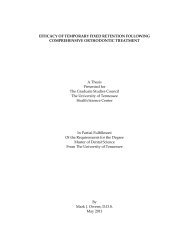BEVACIZUMAB EFFECT ON TOPOTECAN PHARMACOKINETICS ...
BEVACIZUMAB EFFECT ON TOPOTECAN PHARMACOKINETICS ...
BEVACIZUMAB EFFECT ON TOPOTECAN PHARMACOKINETICS ...
You also want an ePaper? Increase the reach of your titles
YUMPU automatically turns print PDFs into web optimized ePapers that Google loves.
most cytotoxic drugs [118, 119]. One approach to overcome the drug resistant and<br />
increase its efficacy is to increase its intratumoral concentration of TPT.<br />
Our previous work [154] has shown that BEV enhanced the penetration of TPT in<br />
orthotopic neuroblastoma xenografts possibly due to the transiently normalized tumor<br />
vasculature. In addition, BEV [155] has been shown to transiently normalize tumor<br />
vasculature in murine Rh30 rhabdomyosarcoma xenograft. Therefore, we hypothesized<br />
that the normalized tumor vasculature by BEV would facilitate the penetration of TPT in<br />
Rh30 RMS xenograft. The specific aim 1 of this project was to determine whether TPT<br />
pharmacokinetics was dependent upon the schedule of BEV and TPT. The specific aim 2<br />
was to assess whether the combination and schedule of TPT and BEV contributed to<br />
differential antitumor activity in the Rh30 mouse model.<br />
2.2 Materials and Methods<br />
2.2.1 Materials and chemicals<br />
TPT (Hycamtin, GlaxoSmithKline, Philadelphia, PA) was prepared in sterile<br />
saline for injection at a concentration of 0.4 mg/ml. BEV (Avastin, Genentech, South San<br />
Francisco, CA) was diluted in sterile saline right before injection from stock<br />
concentration of 25 mg/ml to 1 mg/ml. Isoflurane (Forane) was purchased from Baxter<br />
Pharmaceutical Products (New Providence, NJ). Acetonitrile and triethylamine were of<br />
high-performance liquid chromatography (HPLC) grade. All other chemicals and<br />
solvents used were of analytic grade or better.<br />
2.2.1 Cell culture<br />
The Rh30 pediatric RMS cell line was kindly provided by Dr. Davidoff<br />
(Department of Surgery, St. Jude Children’s Research Hospital) and was grown as a<br />
monolayer in RPMI 1640 medium (Life Technologies Inc., Gaithersburg, MD)<br />
supplemented with 10% fetal bovine serum. When cells reached 80-90% confluency,<br />
they were collected, counted, and resuspended in phosphate-buffered saline (PBS)<br />
solution to prepare a cell suspension of 1×10 4 cells/ μL for tumor inoculation.<br />
2.2.3 Animals<br />
4 to 6-week-old female CB-17 SCID mice were purchased from Charles River<br />
Laboratories (Wilmington, MA). The mice were maintained on a 12 hour light/dark cycle<br />
with access to food and water ad libitum. All procedures were performed in accordance<br />
with a protocol approved by the Institutional Animal Care and Use Committee at St Jude<br />
Children's Research Hospital.<br />
21
















